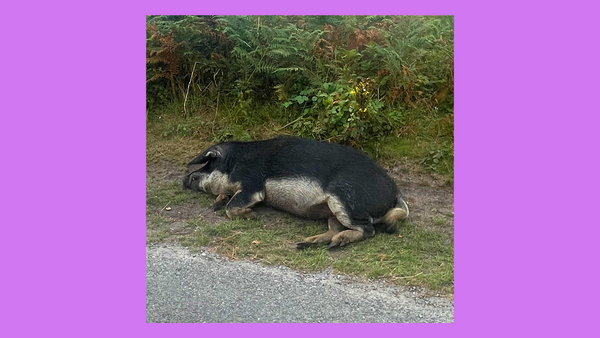Night Water: Year Three
A quantitative look at the third year of this newsletter

On Monday, February 12, Night Water turned three years old. Just over three years ago, I sent out the first email, about my perpetual obsession with Babyland General Hospital, to just 15 subscribers. Today, I’m sending this to around 900.
I started writing Night Water because I wanted to give myself a reason to write every week. This year, I published articles on everything from internet time to bean hole beans, guest posts on the worst Coca-Cola flavors imaginable, and I finally canceled Peacock Premium.
So it’d be a pretty big year even if I hadn’t also decided to move Night Water off of Substack and over to Ghost, a decision I’d made in April but didn’t have the time or energy to tackle until winter. It’s my biggest leap of faith in this newsletter yet, requiring a belief that this work holds at least some value to some people, whether that’s monetarily or purely entertainment—either is good with me.
But we’ll get to all that in a bit. First, I wanted to dig into some of the numbers from this year. I love it when other newsletters, big or small, open the curtain a bit and let us see how the show works, and this is my small contribution to that particular microgenre.
Most importantly: did I actually write something every week?
In the past two years, I’ve set a pretty simple goal: publishing something every week, ideally new, original writing. I didn’t meet that goal this year.
I could blame my big international move to London—it certainly sucked a lot of time and energy out of my life, and the time that wasn’t spent on logistics or selling furniture was spent trying to enjoy every last minute we had in New York.
But even after the move, when life settled a bit and I had plenty of time, I just felt burnt out. I tried to write and nothing clicked. It wasn’t funny, or interesting, or refreshing. And so I stopped, and I missed most of October and November and all of December.
Coming back from that break in January felt good, and it’s clear now that it was much-needed, but I wish that it wasn’t unplanned and uncommunicated to readers.
I’ve spent much of the last month thinking about my writing and publishing schedule and how best to modify it to make it sustainable. I’ve landed on changing my public promise from publishing “every Tuesday” to “most Tuesdays.” It’s a small change, but it helps me feel like I can take a week off every once in a while without feeling bad about it. It’ll also give me space to write good and solid paywalled articles for Day Soda without overloading my schedule.
Let’s talk subscriber growth
Last year, I set a goal to double the email list from 601 to 1202 subscribers. I saw a 260% increase in subscribers in year two, so this felt like a relatively safe goal. If you’ve been paying attention, you already know I missed this goal, instead ending the year with 904 subscribers.

It’s a miracle that anyone wants to my drivel at all, so I can’t thank you enough for being here, whether you’re a day one O.G. or just wandered in off the street, looking for an ice cold glass of water.
So, where did all these people come from? Let’s look at what the analytics have to say. Note that for this entire section, I’m specifically looking at sources for the 300-odd new subscribers from this past year, not my entire subscriber base.

Imported subscribers came from two sources: an advertising experiment I did through the Refind newsletter (that’s the big spike in August) and The Sample, a newsletter recommendation service I’ve written about in previous years.
As far as advertising goes, I found Refind to be successful at getting a lot of people in the door (they have a massive audience and a sophisticated self-serve tool), but I didn’t track churn rate or conversion to paid, so I don’t have much in the way of insights other than grunting “spike big, subscriber base go up” while I swing a large club around.
Compared to previous years, The Sample has been a big disappointment. While it still brings in the occasional subscriber, it’s otherwise dead as a marketing funnel.
The rest is straightforward enough. Direct means anything that can’t be traced, organic search is mostly Google with a sprinkle of Bing, and social is social. “Websites” is my catch-all for any source that doesn’t quite fit those buckets—sites like InboxReads and Rad Letters, a listing I created on LearnedLeague, and the Sleep With Me podcast site.
Uh, what about Substack?
Oh right, that big slice of the pie. One reason writers like Substack and are reticent to leave it is the network. There’s a whole tab in your publication dashboard dedicated to breaking how many of your subscribers Substack can take credit for.
That page just has broad categories—including “Substack existing account,” i.e. claiming a network effect just because someone, incidentally, subscribes to a different Substack newsletter—but you can dig into the specifics if you export your subscriber stats.

The majority of these subscribers came from the recommended newsletters that pop up when you subscribe to a Substack newsletter. While these are legitimate recommendations from the publication, the way they’re included in the subscribe flow is insidious. If you’re just pressing “next” through all of the information they throw at you—Share on Twitter! Subscribe to the podcast!—you might not realize you’ve signed up for another seven newsletters in one fell swoop. I’m not a fan of this implementation; I think it contributes to inflated numbers.
After that are two calls-to-action on post pages, a pop-up subscribe prompt and a large static prompt at the end of posts. Both worked about equally well on Night Water. I hate pop-ups, so it’s unlikely I’ll ever try to implement them here on Ghost, but end-of-post CTAs would be easy to add across the archive.
The other Substack sources—from the dead-on-arrival inbox app to their Twitter competitor Notes—are minuscule and hardly worth fretting about.
While Substack looks to be a significant driver of subscriber growth on the surface, I’m not worried about leaving their network. I might feel differently if I was a larger publication and the network were a scale of magnitude larger. But for Night Water, I don’t think the Substack network is irreplaceable, and I don't think my newsletter is unique.
Elan Ullendorff, who writes a Substack newsletter called Escape The Algorithm, has argued that you shouldn’t take Substack’s network analytics at face value. He asked some recent subscribers to explain how they found his newsletter and checked that against what Substack was saying:
Of the 32 respondents whose estimated source was listed by Substack as itself (about half), the results were decidedly incongruent. Only 5 credited the platform with helping them find me. 84% of respondents attributed their subscription to something or someone other than Substack.
Most of these subscribers would’ve found Elan’s newsletter whether he was on Substack, Ghost, Beehiiv, so on, so forth, because another publication directly linked to something he wrote. Hyperlinking is not a feature Substack built, and it’s a bit rich for them to claim that their network facilitated it.
When I wrote last April about creating a Substack exit strategy, I warned against the platform building walls that make it harder—and eventually, impossible—for you to leave. At the time, I hadn’t even considered that Substack’s own analytics could be part of that wall, but of course they would be. Substack has an incentive to make you think its network effects are more important than they really are, and that leaving them would be catastrophic. We’ll see—maybe next February you’ll be reading my mea culpa, but I think Night Water will be just fine.
It’s time for the top posts of the year
Drum roll, please…
5) Night Water: Year Two & I will never make $18,000 a month with nothing but white noise (tied at 1060 views)
As in previous years, web traffic made all the difference when it came to elevating certain posts above the rest of the pack. But not all web traffic comes from the same place! Last year’s stats round-up attracted interest from social channels, primarily Reddit, while most of the traffic to the white noise piece came from Google, likely from people actually looking for white noise podcasts and not my financial failures.
4) A step-by-step guide to drinking water at night (1080 views)
Believe it or not, a lot of search traffic to this one. I’m a little concerned by how many people seemingly need instruction on this, but as the proprietor of the internet’s leading water-at-night publication, I do owe it to the world to provide such instruction. Such is my cross to bear.
3) An otherworldly trip to Coca-Cola’s Dreamworld (1170 views)
A guest post from Peter Scobas, who followed it up with an excellent sequel a few months later. Mostly search traffic to this one—lot of people trying to figure out what “Dreamworld” is supposed to taste like.
2) What’s the ideal shot and a beer combo? (1210 views)
Lots of Instagram traffic to this one—unsurprising, given I interviewed the proprietor of an Instagram account dedicated to reviewing shot and beer combos. Instagram is generally a pretty bad place to promote links, especially links to articles, so I’m glad this piece was able to connect with its intended audience.
1) You need a Substack exit strategy (1640 views)
An apt #1 for a year that saw wave after wave of controversy wash over Substack HQ—though looking at the search queries that brought people to this article in Google Search Console suggests that most people were just looking for instructions on how to add a custom domain. Oh well!
An updated view of the top posts of all time
While we’re looking at views, let’s do a quick check-in on the top posts from the archive, which should be very familiar to long-time Night Water readers:
5) 5 more Lucozade flavors I drank this month, ranked (2210 views)
4) Star Wars should be in the public domain (3510 views)
3) The Millions Visa Card turns your bank into a lottery (3650 views)
2) We need to talk about bedside water carafes (4320 views)
1) It’s time to bring back HitClips (5640 views)
The vast majority of archive reading comes from organic search traffic. Overall, Night Water posts showed up in 2.32 million searches and got about 13,800 clicks in Year Three, a small improvement over the previous year’s 1.15 million impressions and 9,400 clicks.
Moving to Ghost and looking ahead to Year Four
When I started Night Water, Substack was the natural choice. It was free, it was easy to use, and most importantly, it was free. I liked that emails were published online as well, and approached writing them with a blog’s sensibility at the forefront.
Substack continued to be a good fit as I started taking Night Water more seriously. The company was rolling out growth tools, and experimenting with paid subscriptions was low risk, since I would only pay Substack out of income I’d received.
There were frustrations along the way, of course. Substack’s product was and still is missing major features. Customization on both the web and in emails is severely lacking. Substack also mucks about with your publication—changing layouts, adding pop-ups and pages—without informing you or giving you the chance to opt out.
I know a lot of writers prefer the limitations, but I chafed at the restrictions, and while Substack wasted time building products that no one asked for instead of improving core functionality, competitors like Ghost and Beehiiv quickly caught up and passed Substack in some key areas.
Once you add in a few controversies about anti-vaxxers, Nazis, and moderation, plus the fact that the company is hemorrhaging money, the case for sticking with Substack became thinner and thinner.
I’m in safer hands with Ghost. The platform has drawbacks and trade-offs—there’s no perfect solution out there—but as open-source software with built-in API support, it’s a lot easier to customize to your needs. And if the non-profit that develops Ghost and runs Ghost(Pro), where Night Water is hosted, ever goes belly up, the platform itself can’t die. As long as you can download the latest version from GitHub and install it on a server somewhere, you can continue running your Ghost blog. In terms of exit strategies, that’s hard to beat.
The biggest drawback to Ghost for me is that I am now paying upfront for hosting, and that becomes a fixed cost that I have to pay regardless of how the newsletter is performing. Other added costs—like my podcast host, Transistor, and Outpost, a service that sends autoresponder emails like welcome messages and renewal reminders—also used to come as part of the Substack package. To be clear, I think this stack is a better product than what Substack offers. You get what you pay for. And I wouldn’t have made this choice if it wasn’t important to me and if I didn’t think it would be financially sustainable.
In previous years, I’ve looked ahead and set subscriber growth goals mainly by guesswork and vibes. Did it seem doable to double my subscriber list? Sure! Why not? But this year, I want to make a more concerted effort to grow the paid subscriber base. I’m setting a modest revenue goal that I’m keeping between myself, God, and Day Soda subscribers for now, but it’s enough to cover bills, pay taxes, bring in some interesting guest writers, and hopefully pay for a month or two of my student loan bills. A boy can dream, eh?
Depending on conversion rates, it’ll take between 2000 and 5000 free subscribers to get to that revenue goal. Is this goal doable? Sure! Why not? I have some ideas and experiments to run, and hopefully, some of them work.
Even if they don’t, it’ll be a joy to be able to write and publish this newsletter, and to have it be read and enjoyed by however many people read and enjoy it. Thanks for joining me around the water cooler this year, and I hope you’ll stick around for Year Four.




